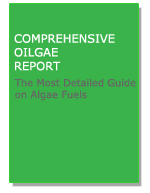Nature gave us oil from algae; perhaps we should try Nature’s way again
Green Algae make up the division Chlorophyta, which includes about 7,500 species of eukayotic, unicellular organisms. Some of the unifying characteristics of this division include similar photosynthetic pigments that make up the chloroplast, which include Chlorophylls a and b, and a -, b -, and g -carotenes; and some xanthophylls and primary carotenoids. Almost all Green algae store their carbohydrates in the form of starch. For the most part, their cell walls are composed of polysaccharides, including cellulose. The most obvious organelle of green algae is their chloroplast, which is responsible for giving them their green color.
The "green algae" is a paraphyletic group because it excludes the Plantae. Like the plants, the green algae contain two forms of chlorophyll, which they use to capture light energy to fuel the manufacture of sugars, but unlike plants they are primarily aquatic. Because they are aquatic and manufacture their own food, these organisms are called "algae," along with certain members of the Chromista the Rhodophyta, and photosynthetic bacteria, even though they do not share a close relationship with any of these groups.
From Wikipedia: “The green algae (singular: green alga) are the large group of algae from which the embryophytes (higher plants) emerged. As such, they form a paraphyletic group, although the group including both green algae and embryophytes is monophyletic (and often just known as kingdom Plantae). The green algae include unicellular and colonial flagellates, usually but not always with two flagella per cell, as well as various colonial, coccoid, and filamentous forms. In the Charales, the closest relatives of higher plants, full differentiation of tissues occurs. There are about 6000 species of green algae. Many species live most of their lives as single-cells, other species form colonies or long filaments.”
Most green algae are present in fresh water, but there are diverse green algae in tropical marine habitats. Like land plants, the greens store starch (amylose or amylopectin) and have chlorophyll a and b as well as secondary pigments : carotenes, lutein, zeaxanthin. (Some Chlorophyta also have siphonoxanthin.) The chloroplast endoplasmic reticulum is absent in green algae, and t heir cell walls are often composed of Cellulose hydroxproline, glycosides, xylans, mannans or sometimes calcium carbonate.
Green algae may be unicellular, multicellular, colonial or coenocytic (composed of one large cell without cross-walls; the cell may be uninucleate or multinucleate). They have membrane-bound chloroplasts and nuclei. Most species are aquatic and are found commonly in freshwater and marine habitats; some are terrestrial, growing on soil, trees, or rocks. Some are symbiotic with fungi giving lichens. Others are symbiotic with animals.
Web Resources
- Chlorophyta (green algae): Over 5,000 species of green algae are known, mostly unicells or simple filaments from fresh water, but there are diverse green algae in tropical marine habitats. Like land plants, the greens store starch (amylose or amylopectin) and have chlorophyll a and b as well as secondary pigments : carotenes, lutein, zeaxanthin. (Some Chlorophyta also have siphonoxanthin.) The chloroplast endoplasmic reticulum is absent in green algae, and t heir cell walls are often composed of cellulose, hydroxproline, glycosides, xylans, mannans or sometimes calcium carbonate.
- Chlorophyta - The Green Algae: Globally distributed, in freshwater, marine, and terrestrial environments Land plants (Kingdom Plantae, or the embryophyta) are specialized green algae adapted to life on land An ancient group according to the fossil record, green algae are extremely diverse. Often dominant algae in freshwater environment.
- Characteristic Chlorophyta: Green Algae: Green colour from Chlorophyll a and b in the same proportions as the 'higher' plants; ß-carotene; and various characteristic xanthophylls. Food reserves starch, some fats or oils like higher plants. Thought to be the origin of the higher green plants but there is currently some doubt on this point.
- Chlorophyta Division: This species list represents some of the more common green seaweeds that might be encountered in California.
Blue-green & Yellow-green algae
- Blue-green Algae: Blue-green algae are types of bacteria known as Cyanobacteria, which occur naturally in habitats such as rivers, lakes, damp soil, tree trunks.
- Introduction to the Cyanobacteria: Cyanobacteria are aquatic and photosynthetic, that is, they live in the water, and can manufacture their own food. Because they are bacteria, they are quite small and usually unicellular, though they often grow in colonies large enough to see.
- Bluegreen Initiative – Overview: Cyanobacteria produce a number of nuisance compounds, including those that are toxic or cause severe taste-and-odor problems in drinking water supplies. Cyanobacterial toxins can make drinking water and recreational use of water unsafe.
- Blue-Green Algae (Cyanobacteria) and their Toxins: Cyanobacteria is the scientific name for blue-green algae, or "pond scum." The first recognized species were blue-green in colour, which is how the algae got their name. Species identified since range in colour from olive-green to red.
- Why be Concerned about Blue-Green Algae?: Blue-green algae, (cyanobacteria) are a common and natural component of the microscopic plants (plankton) in Lake Champlain. Some kinds of blue-green algae produce natural toxins or poisons. When these algae die and break down, toxins can be released into the water.
- Blue Green Algae Benefits: Blue green algae have been used for weight loss and as a nutritional supplement. It has also been used for boosting the immune system and for controlling cholesterol levels.
- Blue-green algae Compositions: Containing Over 64 Vitamins And Minerals, Blue-Green Algae Boosts Your Immune System And Fights Inflammation.
- Health Benefits of Spirulia: Spirulina's scientific name is Arthrospira platensis. This edible algae has a long history of safe human consumption and over 30 years of safety testing. Special farms where Spirulina is cultivated under controlled conditions do not allow the growth of other contaminant blue-green algae, as in lakes and waterways.
- Top 10 Health Benefits Of Blue Green Algae: Blue green algae also contain about 60 to 70% of vegetable protein, and provide all the essential amino acids. All these benefits without the risk of consuming meat, which is high in cholesterol and is difficult to digest.
- Uses And Benefits Of Blue Green Algae: A wild-crafted, organic, all natural superfood, blue green algae is one of best foods in the world. Eating our blue green algae is one of the easiest and most effective ways to stay in healthy.
- Permanently Remove Green Pool Algae: Green algae is a common swimming pool problem, which may appear as a greenish .... Permanently Remove Green Pool Algae.
- Info About Pool Algae: The first noticeable problem is that no one seems to want to go swimming. The second problem is that it requires work and effort and money to rid the water completely of algae. It is therefore best to use preventative chemicals and techniques.
- Algae and Algaecides: A proper chemical program of regular pool maintenance prevents algae from growing. This means keeping the proper pH and recommended free chlorine residual for your pool. The best Algaecide (algae killer) and algaestat (algae inhibitor) is a properly maintained sanitizer level of 1-3 ppM Chlorine or 2-5 ppM Bromine for a pool and 3-5 ppM Chlorine or 3-6 ppM Bromine in a spa.
- Types of Algae in Swimming Pool: Algae is a common problem in swimming pools. What is it; what are the different types & how is it successfully prevented and treated ar explained in this site.
- Pool water problem – algae: Algae is the most common pool water problem only because it is the most visibly obvious one. Algae in itself is not dangerous - in fact it is the main ingredient in many health supplements and tablets. Algae brings danger in that it converts sunlight into food, releasing wastes that become the feeding grounds for unwanted and harmful bacteria and other micro-organisms.
- Fatty acid amides from freshwater green alga Rhizoclonium hieroglyphicum: Freshwater green algae Rhizoclonium hieroglyphicum growing in the Ural Mountains were examined for their fatty acid amides using capillary gas chromatography–mass spectrometry (GC–MS). Eight fatty acid amides were identified by GC–MS. (Z)-9-octadecenamide was found to be the major component (2.26%).
- Introduction to the Chlorophyceae - fresh-water green algae: The Chlorophyceae are a large and important group of freshwater green algae. They include some of the most common species, as well as many members that are important both ecologically and scientifically.
- Toward a Biotic Ligand Model for Freshwater Green Algae: The freshwater green microalgae Chlorella sp. and Pseudokirchneriella subcapitata.
- A Coded List of Freshwater Algae of the British Isles: The purpose of this Coded List is to help those researchers wanting to collect and store information on freshwater and terrestrial algae in the British Isles, by providing a standard set of names and identifying codes. It includes the great majority of known records, though the authors are aware that several groups are not quite complete.
- Australian Freshwater Algae: Pictures of Australian freshwater algae.
- Lake Klamath Blue Green Algae: Lake KIamath is nature's last pure ecological niche for the production of Blue Green Algae on our planet, "nature's first and foundational mother and father generic engineering prototype for Photosynthesis " standing at the very basis of the food chain.
- Klamath Lake Algae - Blue Green Algae News: Klamath lake algae is a whole food that gives a comprehensive nutritional boost, complete in its array of essential amino acids, trace minerals and enzymes. It has an alkaline nature and helps the body balance pH levels.
- Klamath Blue algae Products: Manufacturer/Supplier of Klamath Blue Green Algae & Himalayan Crystal Salt Products.
- What is Klamath blue green Algae?: Klamath Algae are woderfull nutrients for Indigo children. Links & a lot of information. Website for parents and children.
- Introduction to the Xanthophyta Yellow-green Algae: The Xanthophyta include more than 600 species. Members of this group are photosynthetic organisms which live primarily in freshwater, though some are found in marine waters, in damp soil, or on tree trunks. They generally are not abundant when they are found at all, and many species have only been found once. Despite this, they are the dominant producers in some salt marshes, and some, like Tribonema, are cosmopolitan in their distribution.
- Yellow Green Algae: Yellow Green Algae are eucaryotic cells with two apical flagella (anterior and posterior). They contain chlorophyll.
- Yellow-green Algae: The yellow-green or tribophyte algae are named for the genus Tribonema. The group includes about 100 genera, many of which are rare.
- What is this Wild Freshwater Blue Green Algae?: Aphanizomenon flos-aquae grows in wild abundance in Klamath Lake in Southern Oregon. The shallow lake is fed by pure waters called the "Rivers of Light", and the algae that grows in the lake is nourished by 35 feet of volcanic mineral-rich sediment on the bottom and sunlight almost every day of the growing season.
- How Spirulina is Different from Wild Blue Green Algae: Many people have asked about the differences between spirulina and wild blue-green algae harvested from lakes. Spirulina is one particular kind of blue-green algae with a centuries long history of safe human consumption. It is well known to be safe and nutritious. Hundreds of published scientific studies over the past thirty years have documented no toxicity.
- Wild Blue-green Algae : This guide provides information on the blue-green algae of Upper Klamath Lake, in Oregon, in the USA. This algae is rich in nutrients, and can, if taken as a dietary supplement, improve health and vitality by stimulating the immune system and boosting brain activity.
Other Related Sections
Blue Green Algae, Red Algae, Green Algae, Marine Algae, String Algae, Pond Algae, Pond Algae Control, Algae Control; Algae – World of Algae
Energy & Alternative Energy
Energy
Portal – Discussed topics such as alternative & renewable energy,
peak oil, energy industry inventions & discoveries, and more.
Energy Sources - Main Sections






